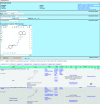BindingDB in 2015: A public database for medicinal chemistry, computational chemistry and systems pharmacology
- PMID: 26481362
- PMCID: PMC4702793
- DOI: 10.1093/nar/gkv1072
BindingDB in 2015: A public database for medicinal chemistry, computational chemistry and systems pharmacology
Abstract
BindingDB, www.bindingdb.org, is a publicly accessible database of experimental protein-small molecule interaction data. Its collection of over a million data entries derives primarily from scientific articles and, increasingly, US patents. BindingDB provides many ways to browse and search for data of interest, including an advanced search tool, which can cross searches of multiple query types, including text, chemical structure, protein sequence and numerical affinities. The PDB and PubMed provide links to data in BindingDB, and vice versa; and BindingDB provides links to pathway information, the ZINC catalog of available compounds, and other resources. The BindingDB website offers specialized tools that take advantage of its large data collection, including ones to generate hypotheses for the protein targets bound by a bioactive compound, and for the compounds bound by a new protein of known sequence; and virtual compound screening by maximal chemical similarity, binary kernel discrimination, and support vector machine methods. Specialized data sets are also available, such as binding data for hundreds of congeneric series of ligands, drawn from BindingDB and organized for use in validating drug design methods. BindingDB offers several forms of programmatic access, and comes with extensive background material and documentation. Here, we provide the first update of BindingDB since 2007, focusing on new and unique features and highlighting directions of importance to the field as a whole.
© The Author(s) 2015. Published by Oxford University Press on behalf of Nucleic Acids Research.
Figures



References
-
- Chen X., Liu M., Gilson M.K. BindingDB: A Web-accessible molecular recognition database. Comb. Chem. High Throughput Screen. 2002;4:719–725. - PubMed
Publication types
MeSH terms
Substances
Grants and funding
LinkOut - more resources
Full Text Sources
Other Literature Sources

